

Al Madrigal’s New Special ‘Half Like Me’ Is What Latinos Have Been Waiting For
Al Madrigal goes on a journey of self-discovery… starting with how to pronounce his own name.
In his new one-hour special “Half Like Me,” premiering on Fusion on January 22, The Daily Show’s senior Latino correspondent travels across the U.S. to discover what it means to be half Mexican and half white.
“Being half has always been confusing,” Madrigal says in the preview for the special. “White people think you’re Mexican and Latinos give me shit about not being Latino enough.”…
Link to article
The Things All White Latinos Are Tired of Hearing
As a white Latina, if I had a dollar for every time someone said to me, “You’re whiter than I am!” I’d have enough money to … well, the point is, I’d be making it rain, OK?
(Also, yes: I’m aware that I’m whiter than you. Trust me. I’d like to be able to tan as easily as you think I do, but alas, that’s not really in the cards for me.)
For many people, it’s not the most offensive thing ever to be told you don’t look Latina or to be asked if you’re adopted or to be asked why you’re white if you’re Latina, but the truth is, people often have a specific, stereotypical idea of what it means to be Latino in the U.S. today, and often that idea is at odds with the reality that pale-skinned, blue-eyed, or blonde Latinos actually can and do exist. After a while, it gets kind of annoying to constantly have to “prove” to people — Latinos and non-Latinos alike — how “Latina” you really are…
Link to article
In 3 Minutes, This Video Will Completely Change the Way You Think About Race
By Marcie Bianco January 14, 2015
Is “race” just another label?
From Raven-Symoné to Toni Morrison, a growing number of people are now claiming that race is a social construct. As Morrison told Stephen Colbert last year, “There’s no such thing as race. None. There’s just the human race, scientifically, anthropologically. Racism [too] is a construct.” Not that race isn’t without benefits, she explained: “Money can be made off of it. People who don’t like themselves can feel better because of it. … It has a social function.”
But what does that actually mean? Jenée Desmond Harris, in a new video for Vox, has created an excellent primer for anyone confused about the concept. Whether you agree with her or not, this three-minute video will almost certainly get you thinking differently about race…
Link to article
The Election of Pete Chacón: Latino Hope, Pride and a New Belief in the System
By Maria E. Garcia
Peter “Pete” Chacón
The general public knew Peter Chacón as a California State Assemblyman who served from 1970-1992. Very few know or understand what Pete’s election meant to the Latino community.
From the time I was a small child I remember my parents going inside a building to vote. They would take turns voting as we sat in the car. One parent would go inside to vote while the other parent would care for us. Then the reverse would occur. Voting was always a special activity and in many ways a mystery…
Link to article
George I. Sánchez : the long fight for Mexican American integration
“George I. Sánchez was a reformer, activist, and intellectual, and one of the most influential members of the ‘Mexican American Generation’ (1930-1960). A professor of education at the University of Texas from the beginning of World War II until the early 1970s, Sánchez was an outspoken proponent of integration and assimilation. He spent his life combating racial prejudice while working with such organizations as Read more..
Link to summary and availability
Mexican professionals bringing ambition, startups to North Texas
Dallas Morning News
A cocktail mixer sponsored by the Association of Mexican Entrepreneurs …. “Americans respect power, and that’s what we’re striving for, economic …
Link to article
Slow and Steady Progress for Mexican American Professionals: The results of the American surveys for the years 2010-2012 show positive results
By Humberto Gutierrez
Edited by Kristen House
College enrollment showed an increase of 1.4 percent from 2010 to 2012—a positive sign for Mexican Americans wanting to achieve higher academic and professional goals. Here is the data.

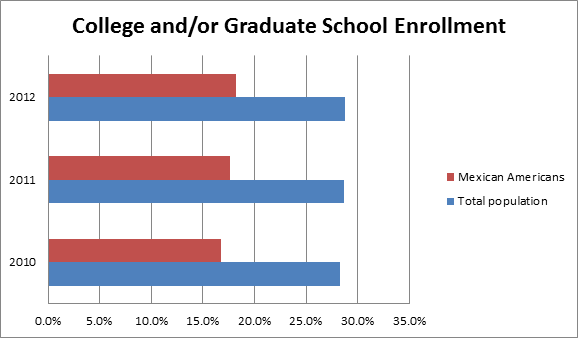
Educational attainment shows no change to the terrible numbers of 2.6 percent for the years 2010 and 2011 but there is hope in that 2012 showed a small gain to 2.9 percent.

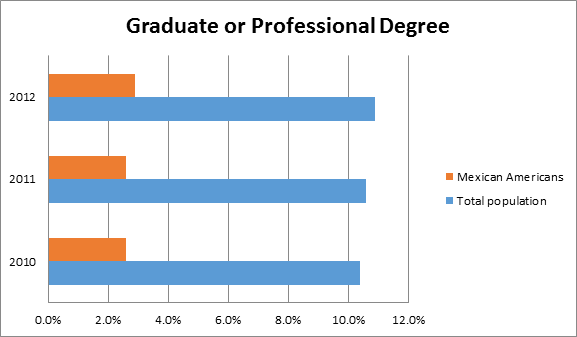
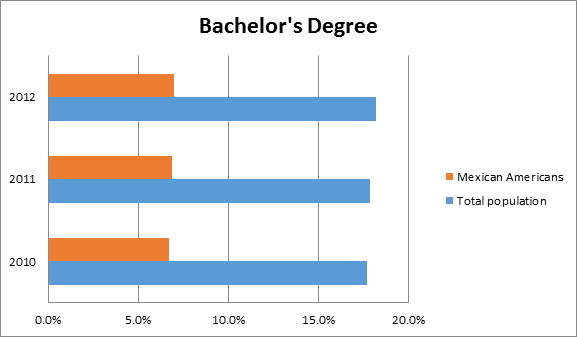
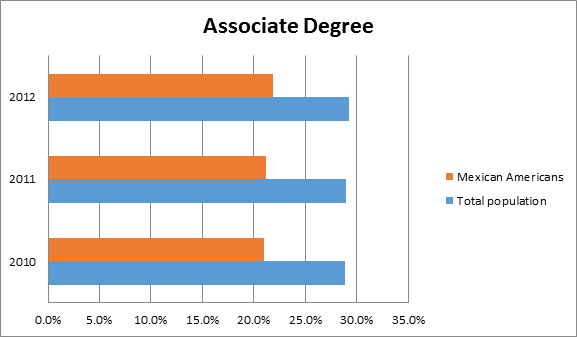
For occupations, there was a .2 percent increment yearly, but still shows that in management, business, science, and art occupations, there is still a wide gap between the total population at 36.1 percent for the year 2012 and 16.6 percent for Mexican Americans.


For professional, scientific, and management and administrative and waste management services, there is a close correlation between the percentage represented by the total population and Mexican Americans.

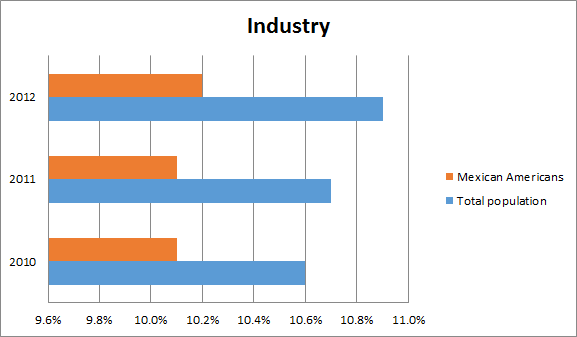
Summary:
There is hope at the end of the tunnel. College and university enrollment has been trending higher for Mexican Americans. Unfortunately, the percentage of students with graduate degrees stayed the same for the years 2010 and 2011, but rose a small amount in 2012. Percentages showing students with BA and AA degrees trended higher—an encouraging sign. Occupations still showed a wide margin between the total population and Mexican Americans. The Mexican American population showed a small increase in professional, scientific, and management and administrative and waste management employment while the total population showed a small but steady increase in this area.
References:
- Census Bureau, Selected Population Profile in the United States: 2010 – 2012
- United States S0201. Selected population Profile in the United States
- Population Group: Mexican and Total Population
- Data Set: American Community Survey 1-Year Estimates
Hopeful Gains in Higher Education for Mexican Americans
By Humberto Gutierrez
Edited by Kristen House
The latest figures from the 2013 American Community Survey show progress in the wide gap between the total US professional population and Mexican Americans:
- 2012 college and/or graduate enrollment was 28.8% for the total population but only 18.2% for Mexican Americans.
- 2013 college and/or graduate enrollment was 28.3% for the total population, 18.1% for Mexican Americans, and 33.3% for foreign-born Mexican Americans.
College enrollment for the total population has decreased from the years 2012 to 2013 by 463,000 according the Census Bureau as stated in their Sept. 24, 2014 press release.
For Mexican Americans, there was also an enrollment decrease, but not as pronounced. Mexican American enrollment dropped by only .1% whereas for the total population, there was a .5% drop in college enrollment.

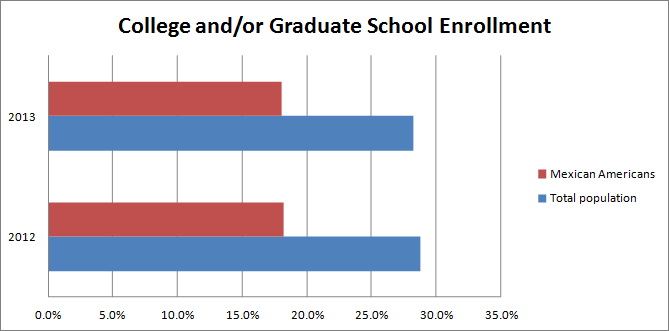
EDUCATIONAL ATTAINMENT
Educational attainment for the general population has risen by .3% from the years 2012 to 2013. For Mexican Americans, it has decreased by .1%
Earned bachelor’s degrees for the general population have risen by .2% and a bit more for Mexican Americans at .3%
Associate degrees and/or some college has shown little change across the board.
Unfortunately, only 2.8% of Mexican Americans and 1.5% of foreign-born Mexican Americans completed a graduate or professional degree in 2013. This is an extremely low percentage because the total population completion of a graduate or professional degree in 2013 was 11.2%. Why are Mexicans and native-born Mexicans not obtaining their graduate degrees? While only 7.3% of Mexican Americans have B.A. degrees, many are settling for associate degrees—21.8% of Mexican Americans and 12.1% of foreign-born Mexican Americans are ending their academic careers upon achieving these two-year degrees, according to the 2013 data.
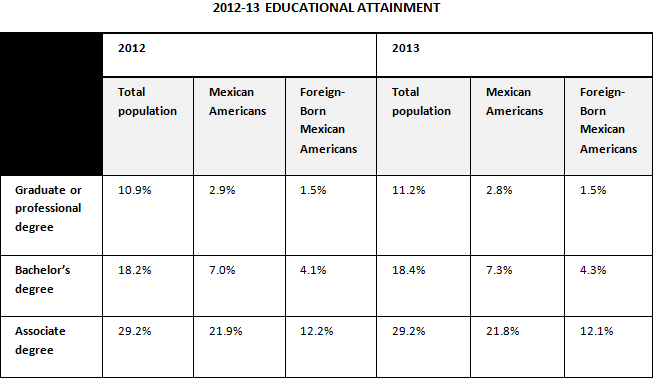

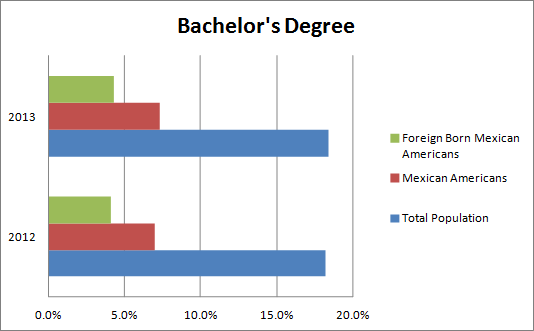
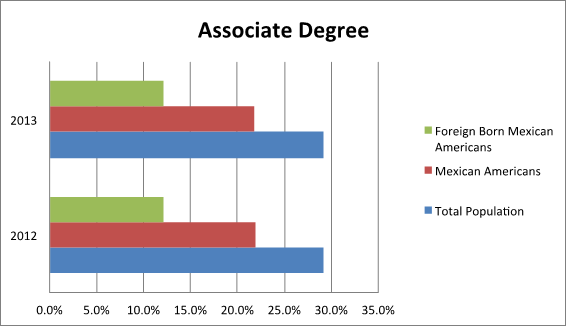
OCCUPATIONS
For the year 2013, the data for civilian employed population 16 years and over in management, business, science, and arts occupations is: 36.3% for the total population, 16.7% for Mexican Americans, and 9.2% for foreign-born Mexican Americans. Again, dismal figures.
Compared to the 2012 results, which were for the total population of 36.1% and for Mexican Americans 16.6%, there was a .2% increase for the total population and .1% for Mexican Americans. There was also a .2% increase for foreign-born Mexican Americans. Not much change, but some hope.
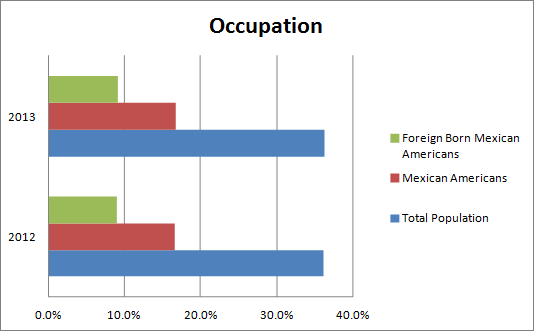
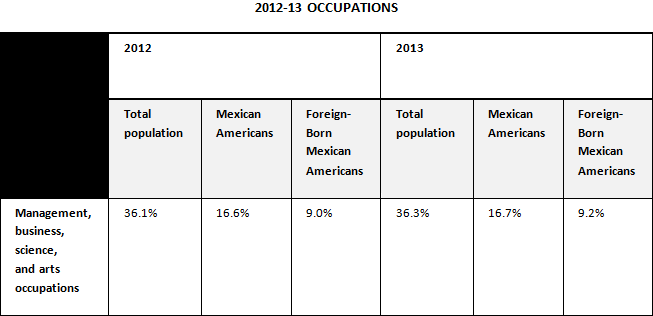
INDUSTRY
For professional, scientific, management and administration, and waste management services, 2013 employment for the total population was 11.1% and 10.2% for Mexican Americans, with foreign-born Mexican Americans at 11.5%. The 2012 results were for the total population 10.9% and 10.2% for Mexican Americans with the foreign-born Mexican Americans at 11.6%. No change for Mexican Americans and a .2% increase for the total population. However, a happy surprise: in 2013, foreign-born Mexican Americans topped all groups at 11.5% with a small decrease from 2012.
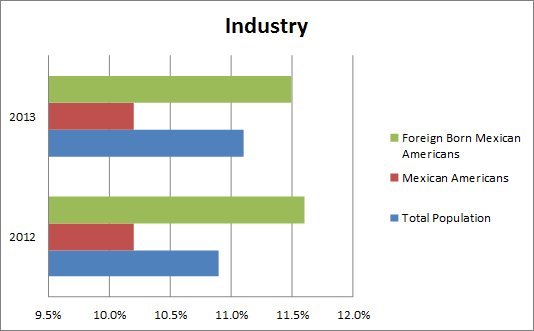
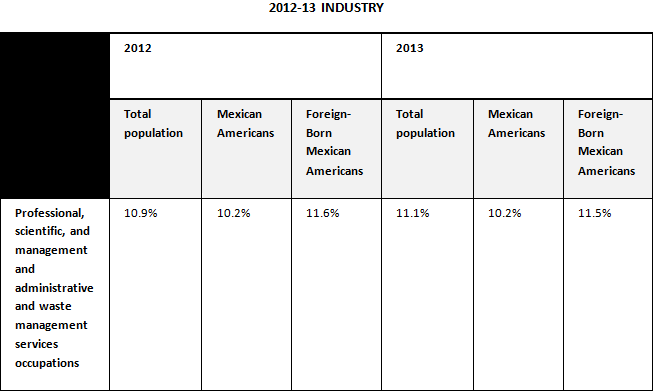
This represents a mixed picture for Mexican Americans and for foreign-born Mexican Americans in their quest for parity with the total population.
Solution for Retaining Minority Students in Higher Education
Scott Watson Swail’s 2003 report (1) on student retention programs in higher education states that a comprehensive student retention program should:
- rely on proven research
- suit the particular needs of the campus
- be institutionalized and become a regular part of campus service
- involve all campus departments and all campus personnel
- take into consideration the dynamics of the change process and provide extensive and appropriate retraining of staff
- be student centered
- operate in a cost-effective way, and not be tied to soft monies
- have the support of a comprehensive student monitoring system that will become the foundation of all institutional research on campus and support every department
- be sensitive to student needs and to diverse populations.
At least some of the above recommendations would go a long way to encourage many minority students to continue their higher education by obtaining a graduate or professional degree.
Berkley, Stanford, UCLA, and Caltech collaborate to boost minority Ph.D. students by recruiting underrepresented students in mathematical, physical and computer sciences, and in engineering.
UC Berkley put it best: “The four schools are creating a unique, cross-institutional community of underrepresented minority Ph.D. students, postdoctoral scholars, and faculty members in the targeted fields; developing faculty training to better recognize and help these students thrive and advance; and conducting research that includes annual surveys of Ph.D. students about what factors impact their attitudes, experiences and preparation for the future.”(2)
References
- Census Bureau, Selected Population Profile in the United States: 2012 and 2013
- United States S0201 and B 05006. Selected population Profile in the United States
- Population groups: Mexican and Mexico (foreign-born)
- Data set: American Community Survey 1-Year Estimates for years 2012 and 2013.
- Census Bureau, American Fact Finder, Selected population Profile in the Untied States.
————————————————–
(1) Watson Scott Swail, Retaining Minority Students in Higher Education: A Framework for Success, George Washington University, 2003
(2) Gretchen Kell, “Berkeley, Stanford, UCLA, Caltech unite to boost number of minority Ph.D. students, faculty,” UC Berkley News Center, February 13, 2014
Extraordinary Women in Texas: A Phenomenological Study of Mexican American Female Superintendents
SA Rodriguez – 2014
… from family and professional colleagues. These support mechanisms assisted them in coping
with cultural incongruence and school board affairs. The strategies and skills that the participants
depicted in this study will provide aspiring Mexican American female superintendents …
Link to dissertation
Mexican American Mobility: Early Life Processes and Adult Wealth Ownership
LA Keister, JA Vallejo, EP Borelli – Social Forces, 2014
… capital who encounter a positive context of reception will have children (the second generation)
who attain professional occupations and … Empirical tests of segmented assimilation compare young
adults from various immigrant groups and find that Mexican American youth face …
Link to abstract
Educational decisions and academic achievement: A focus on Mexican American students
This mixed methods study examines factors associated with student learning outcomes
for Mexican American students in the public elementary schools. The problem of disproportionate identification of cultural and
linguistically diverse students in special education is addressed. This study looks at 23 third and fourth
grade students by means of a retroactive educational records review; an interview with a subset of educators and parents and the use of
member checks with a select group of adult participants to evaluate the validity of the interpreted
results. The results from this study affirm the effect of categorical factors previously described in
the literature as having positive or negative effects of academic achievement and identifies specific team…
Link to study
TJ conference explores Mexican diaspora
For years, whenever Enrique Hernandez was traveling abroad and people asked him where he’s from, he would give this answer: “We’re from Mexico City, but we’re living in San Diego.”
Lately, his response has become: “We’re from San Diego. Originally from Mexico City, but from San Diego.”
A Harvard-educated former government official in Mexico City, Hernandez is now partner in a law firm. He is also part of a diverse cohort of Mexicans who have decided to leave their home country for the United States. Some are doctors, lawyers, scholars, artists and entrepreneurs, while others are laborers and service workers…
Link to article
Images of Latinos in U.S. culture to be examined in 1-night lecture, exhibit at UT El Paso
The UTEP Department of Communication and the Chicano Studies program presents a lecture and exhibit by Dr. William Anthony Nericcio that examines American visual culture reflecting images and stereotypes of Latinas/os. The event, Mextasy: Seductive Hallucinations of Latina/o Mannequins Prowling the American Unconscious , will be at 5:30 pm, Wednesday, Oct. 15 in Quinn Hall Room 212 at the University of Texas at El Paso.
Mextasy is a traveling art…
Link to article
5 influential inventions by Latinos
Some of the things you have used -and some you haven’t- were invented by a Latino and you didn’t even know it.
Link to article
Father Involvement in Mexican American Families
DS Roubinov – 2014
Page 1. Father Involvement in Mexican American Families by Danielle S. Roubinov … Linda Luecken.
Over the past several years, her guidance has helped me to take strides from graduate student
to researcher, clinician, and professional. I credit Dr. Luecken’s …
Link to dissertation
New Digital Archive Details Challenges for Mexican Journalists, Migrants
An innovative, open-access archive documenting personal stories of journalists who have been silenced, and also government processes that cannot be videotaped or photographed, is being introduced at the University of Arizona.
Called “The Documented Border,” the digital archive includes original border-related research material collected and curated by UA faculty along the U.S.-Mexico border, representing a unique resource for researchers, scholars and others interested…
Link to article
Anchor and launching pad: The role of a Latino cutlural center in the experience of Mexican American students at a Midwestern predominantly White institution
SA Lozano – 2014
… activities? 3. What role does the cultural center play in Mexican American student success? …
because they are not staffed with full-time professionals. Rather, each center employs a half- …
Center is planned and coordinated by students rather than by professional staff members. …
Link to dissertation
Mexican American Youth Organization: Avant-guarde of the Chicano movement in Texas
A Navarro – 2014 – books.google.com
… Although other sectors were involved (eg, campesinos, workers, professionals, etc.), it was the youths who became the most … To understand the Mexican American Youth Organization (MAYO),then, itis important to understand the relationships among the divergent movements …
Link to book
Mexican American College Students’ Communication with Their Siblings
SE Killoren, EC Alfaro, AK Lindell, C Streit – Family Relations, 2014
… Original Article. Mexican American College Students’ Communication with Their Siblings. … How
to Cite. Killoren, SE, Alfaro, EC, Lindell, AK and Streit, C. (2014), Mexican American College
Students’ Communication with Their Siblings. Family Relations, 63: 513–525. …
Link to abstract
The Role of Physical Activity and Sedentary Behaviors in Explaining the Association Between Acculturation and Obesity Among Mexican-American Adults
R Murillo, SS Albrecht, ML Daviglus, KN Kershaw – American Journal of Health …, 2014
… The Role of Physical Activity and Sedentary Behaviors in Explaining the Association
Between Acculturation and Obesity Among Mexican-American Adults … Subjects.
Mexican-American NHANES participants aged !20 years (n ¼ 1902). Measures. …
Link to abstract


